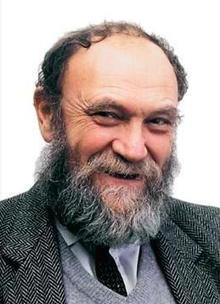Vladimir Arlazarov
Vladimir L’vovich Arlazarov (Russian Арлазаров Владимир Львович) is a Russian computer scientist born in Moscow.

Research work
In 1965 at Alexander Kronrod’s laboratory at the Moscow Institute for Theoretical and Experimental Physics (ITEP), Vladimir Arlazarov co-developed the ITEP Chess Program, together with Georgy Adelson-Velsky, Anatoly Uskov and Alexander Zhivotovsky, advised by Russian chess master Alexander Bitman and three-time world champion Mikhail Botvinnik.
At the end of 1966 a four game match began between the Kotok-McCarthy-Program, running on an IBM 7090 computer, and the ITEP Chess Program on a Soviet M-20 computer. The match played over nine months was won 3-1 by the ITEP program, despite playing on slower hardware.
By 1971, Mikhail Donskoy joined with Arlazarov and Uskov to program its successor on an ICL System 4/70 at the Institute of Control Sciences, called Kaissa, which became the first World Computer Chess Champion in 1974 in Stockholm.
Arlazarov is one of the inventors of the Method of Four Russians.
Selected publications
- Adelson-Velsky, Georgy; Arlazarov, Vladimir; Bitman, Alexander; Zhivotovsky, Alexander; Uskov, Anatoly (1970), Programming a Computer to Play Chess, Russian Mathematical Surveys, 25, pp. 221–262
- Adelson-Velsky, Georgy; Arlazarov, Vladimir; Donskoy, Mikhail (1975), "Some Methods of Controlling the Tree Search in Chess Program", Artificial Intelligence, 6 (4): 361–371, doi:10.1016/0004-3702(75)90021-1, ISSN 0004-3702 Reprinted in Computer Chess Compendium
- Adelson-Velsky, Georgy; Arlazarov, Vladimir; Donskoy, Mikhail (1977), "On the Structure of an Important Class of Exhaustive Problems and Methods of Search Reduction for them", Advances in Computer Chess, 1
- Adelson-Velsky, Georgy; Arlazarov, Vladimir; Donskoy, Mikhail (1979), Jean Hayes Michie, Donald Michie and L.I. Mikulich (ed.), "Algorithms of adaptive search", Machine Intelligence, Chichester: Ellis Horwood, 9, pp. 373–384
- Adelson-Velsky, Georgy; Arlazarov, Vladimir; Donskoy, Mikhail (1988), Algorithms for Games, New York, NY: Springer-Verlag, ISBN 3-540-96629-3
- Arlazarov, Vladimir; Futer, Aaron L. (1979), Jean Hayes Michie, Donald Michie and L.I. Mikulich (ed.), "Computer Analysis of a Rook End-Game", Machine Intelligence, Chichester: Ellis Horwood, 9, pp. 361–371
See also
References
As of this edit, this article uses content from "chessprogramming - Vladimir Arlazarov", which is licensed in a way that permits reuse under the Creative Commons Attribution-ShareAlike 3.0 Unported License, but not under the GFDL. All relevant terms must be followed.
External links
- Vladimir Arlazarov's ICGA Tournaments
- Vladimir Arlazarov at Cognitive Technologies
- The Fast Universal Digital Computer M-2 from the Russian Virtual Computer Museum
- Early Reference on Bit-Boards by Tony Warnock, rec.games.chess archive, October 29, 1994